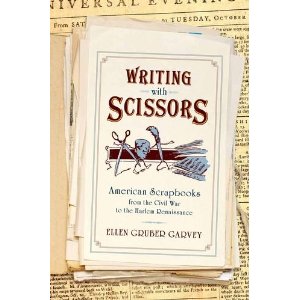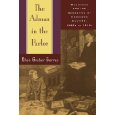Writing wi th Scissors: American Scrapbooks from the Civil War to the Harlem Renaissance
th Scissors: American Scrapbooks from the Civil War to the Harlem Renaissance
Men and women 150 years ago grappled with information overload by making scrapbooks-the ancestors of Google and blogging. From Abraham Lincoln to Susan B. Anthony, African American janitors to farmwomen, abolitionists to Confederates, people cut out and pasted down their reading. Writing with Scissors opens a new window into the feelings and thoughts of ordinary and extraordinary Americans. Like us, nineteenth-century readers spoke back to the media, and treasured what mattered to them.
In this groundbreaking book, Ellen Gruber Garvey reveals a previously unexplored layer of American popular culture, where the proliferating cheap press touched the lives of activists and mourning parents, and all who yearned for a place in history. Scrapbook makers documented their feelings about momentous public events such as living through the Civil War, mediated through the newspapers. African Americans and women’s rights activists collected, concentrated, and critiqued accounts from a press that they did not control to create “unwritten histories” in books they wrote with scissors. Whether scrapbook makers pasted their clippings into blank books, sermon collections, or the pre-gummed scrapbook that Mark Twain invented, they claimed ownership of their reading. They created their own democratic archives.
Writing with Scissors argues that people have long had a strong personal relationship to media. Like newspaper editors who enthusiastically “scissorized” and reprinted attractive items from other newspapers, scrapbook makers passed their reading along to family and community. This book explains how their scrapbooks underlie our present-day ways of thinking about information, news, and what we do with it.
Order from Indiebound,Oxford University Press, Barnes & Noble, or Amazon
The Adman in the Parlor: Magazines and the Gendering of Consumer Culture, 1880s-1910s — winner, best book of the year on book history, from SHARP (Society for the History of Authorship, Reading, and Publishing)
How did advertising come to seem natural and ordinary to magazine readers by the end of the nineteenth century? The Adman in the Parlor explores how readers interacted with advertising during a period when not only consumption but advertising itself became established as a pleasure. Garvey argues that readers’ participation in advertising, rather than top-down dictation by advertisers, made advertising a central part of American culture. Garvey’s analysis interweaves such texts and artifacts as advertising trade journals, magazines addressed to elite, middle class, and poorer readerships, scrapbooks, medical articles, paper dolls, chromolithographed trade cards, and contest rules. New forms of fictional realism made shopping and brand names seem ordinary and natural.
As magazines became dependent on advertising rather than sales for their revenues, women’s magazines led the way in turning readers into consumers through the interplay of fiction, editorials, and advertising. General magazines, too, saw little conflict between these different interests. Instead, advertising and fiction helped one another. Magazine stories illustrated the multiple desires and social meanings embodied in the purchase of a product. Garvey takes the bicycle as a case study, and tracks how magazines mediated among competing medical, commercial, and feminist discourses to produce an alluring and unthreatening model of women bicycling in their stories.
Advertising formed the national vocabulary. At once invisible, familiar, and intrusive, advertising both shaped fiction of the period and was shaped by it. The Adman in the Parlor unearths the lively conversations among writers and advertisers about the new prevalence of advertising for mass-produced, nationally distributed products. (Oxford University Press, 1996)
Order from Indiebound, Barnes & Noble, Oxford University Press, or Amazon Kindle


